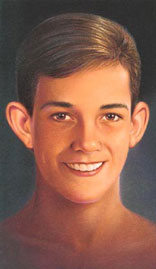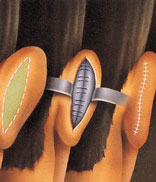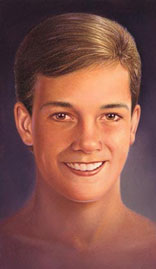Ear Pinning Surgery (Otoplasty) Washington DC
Introduction
Dr. Baker typically performs ear surgery (otoplasty) to set prominent ears back closer to the head or to reduce the size of large ears. If you are considering ear surgery for yourself or your child, this information will give you a basic understanding of the procedure: when it can help, how it is performed, and what results you can expect. It cannot answer all of your questions, since a lot depends on your individual circumstances. Please be sure to ask Dr. Baker if there is anything you do not understand about the procedure.

Ears that appear to stick out or are overly large can be helped by ear surgery.

An incision is made in the back of the ear so cartilage can be sculpted or folded. Stitches are used to close the incision and help maintain the new shape.

Am I a Candidate for Ear Surgery?
This operation is usually done on children between the ages of six and 14. Ears are almost fully grown by age four, and the earlier the surgery is completed, the less teasing and ridicule the child will have to endure. However, the cartilage needs to be strong enough to hold the sutures used to create the new shape. Ear surgery on adults is also possible, and there are generally no additional risks associated with ear surgery on an older patient. For children it is helpful if they show behavior indicative of good postoperative compliance.
Dr. Baker’s Credentials for Ear Surgery
- Professor of Plastic Surgery, Medstar Georgetown Department of Plastic Surgery
- Medical Director Inova Children’s Hospital Craniofacial Anomalies Program
- Director Medstar Georgetown Center for Facial Restoration
- Authored multiple peer-reviewed manuscripts on ear anomalies
- Training in plastic surgery, maxillofacial surgery, and craniofacial surgery provide him the tools to perform a complete assessment of each patient’s facial structure. He is trained in all modalities of addressing your problems, so he is not limited in the solutions he can provide to address your concerns.
Evaluation
Prominent ears Most patients who present for ear surgery have a concern about the prominence or the projection of their ears. For this type of a problem, an otoplasty (ear pinning) surgery is recommended.
Other ear problems Besides protruding ears, there are a variety of other ear problems that can be helped with surgery. These include: lop ear, when the tip seems to fold down and forward; cupped ear, which is usually a very small ear; and shell ear, when the curve in the outer rim, as well as the natural folds and creases, are missing. Surgery can also improve large or stretched earlobes, or lobes with large creases and wrinkles. Dr. Baker can even build new ears for those who were born without them or who lost them through injury. Ask Dr. Baker about the effectiveness of surgery for your specific case.
Infant Nonsurgical Ear Correction (Earwell) – Please see Earwell section of website
What Is an Otoplasty (Ear Surgery)
Ear surgery usually takes about two hours, although complicated procedures may take longer. The technique will depend on the problem.
With one of the more common techniques, Dr. Baker will make a small incision in the back of the ear to expose the ear cartilage. He will then sculpt the cartilage and bend it back toward the head. Non-removable stitches are used to help maintain the new shape. In most cases, ear surgery will leave a faint scar in the back of the ear that will fade with time. Even when only one ear appears to protrude, surgery is usually performed on both ears to optimize postoperative symmetry.
Most patients, young and old alike, are thrilled with the results of ear surgery. However, keep in mind the goal is improvement, not perfection. Do not expect both ears to match perfectly; perfect symmetry is both unlikely and unnatural in ears. If you have discussed the procedure and your expectations with Dr. Baker before the operation, you will likely be pleased with the result.
Preparing for Your Surgery
Most surgeons recommend that parents stay alert to their child’s feelings about protruding ears and do not insist on the surgery until your child wants the change. Children who feel uncomfortable about their ears and want the surgery are generally more cooperative during the process and happier with the outcome.
In the initial meeting, Dr. Baker will evaluate your child’s condition, or yours if you are considering surgery for yourself, and recommend the most effective technique. Dr. Baker will also give you specific instructions on how to prepare for surgery. Whether Dr. Baker performs your ear surgery at Georgetown University Hospital (Washington D.C.), Inova Fairfax Hospital (Falls Church, VA) or an ambulatory surgical facility (McLean, VA), you should arrange for someone to drive you home after your surgery, and to help you out for a day or two.
Anesthesia
If your child is young, Dr. Baker recommends general anesthesia, so the child will sleep through the operation and the anesthesiologist will establish a protected airway, which is safest for your child. For older children or adults, Dr. Baker may prefer to use local anesthesia, combined with a sedative, so you or your adolescent will be awake, but relaxed.
Risks and Complications
When a qualified surgeon performs ear surgery, complications are infrequent and usually minor. Nevertheless, as with any operation, there are risks associated with surgery and specific complications associated with this procedure. A small percentage of patients may develop a blood clot behind the ear. It may dissolve naturally or can be drawn out with a needle. Occasionally, patients develop an infection in the cartilage, which can cause scar tissue to form. Such infections are usually treated with antibiotics. The most common complication is a recurrence of the original malposition. Fortunately, all of these potential complications occur infrequently.
Where The Surgery Will Be Performed
For children, Dr. Baker performs ear surgery as an outpatient procedure in a hospital with pediatric anesthesiologists. Adults may have the procedure done in a hospital or an outpatient facility. Whether Dr. Baker performs your ear surgery at Georgetown University Hospital (Washington D.C.), Inova Fairfax Hospital (Falls Church, VA) or an ambulatory surgical facility (McLean, VA), you should arrange for someone to drive you home after your surgery.
Recovery
Adults and children are usually up and around within a few hours of surgery and are able to go home the same day. The patient’s head will be wrapped in a bulky bandage immediately following surgery to promote the best molding and healing. The ears may throb or ache a little for a few days, but this can be relieved by medication. Within one week, the bulky bandages will be replaced by a lighter head dressing similar to a headband. Be sure to follow Dr. Baker’s directions for wearing this dressing, especially at night. Sutures usually will dissolve in about two weeks.
Any activity in which the ear might be bent should be avoided for a month or so. Most adults can go back to work about five days after surgery. Children can go back to school in approximately seven days if they are careful about playground activity. You may want to ask your child’s teacher to keep an eye on the child for a few weeks.






